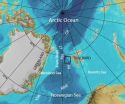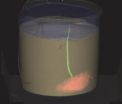(Press-News.org) WASHINGTON, DC - April 14, 2015 - A new study has demonstrated that genetically modified Salmonella can be used to kill cancer cells. The study is published in this week's issue of mBio, an American Society for Microbiology online-only, open access journal.
"There has long been interest in using genetically engineered microbes to target and destroy cells within solid tumors. I think this study goes a significant way in developing some strategies that will help in the overall means of using Salmonella as part of a cancer therapy," said Roy Curtiss, III, PhD, who was involved with the research. Dr. Curtiss is University Professor of Microbiology and Director, Center for Infectious Diseases and Vaccinology and Center for Microbial Genetic Engineering, the Biodesign Institute, Arizona State University.
For years, researchers have known that certain strains of bacteria, including Salmonella enterica, can kill cancer cells. Specifically Salmonella enterica Serovar Typhimurium has been shown to not only colonize solid tumors, but also to exhibit an intrinsic antitumor effect. However, in order to use Salmonella as a weapon against cancer in humans, researchers must find a balance between allowing it to kill the cancer and be safe for the patient. The bacteria, commonly known for causing severe food poisoning, can lead to sepsis and death in humans.
In the new study, the researchers focused on modifying the lipopolysaccharide structure (LPS) of the Salmonella strain to make the bug less toxic. LPS, found in the outer membrane of bacteria, is one of the major inducers of sepsis, a life-threatening infection. The researchers used genetic engineering to delete genes involved in the synthesis of the LPS, and then tested various modified Salmonella strains to see how they performed in test tube studies with human cancer cells and in tumor bearing mice. They identified a particular mutant strain that was the most effective at killing cancer cells and shrinking tumors, and also unable to cause disease. However, this mutant strain was less able to colonize the tumors, although being most effective in killing tumor cells when getting there.
To address this problem, the researchers then added another genetic modification, an inducible arabinose promoter. The modification allowed the Salmonella to be injected in the mouse in a form that would not harm normal, healthy cells, was effective at colonizing tumors, and after entering cancer cells, would turn toxic. "This transition from a benign, invasive Salmonella that doesn't hurt normal cells to the toxic type occurs very rapidly (time wise) in the tumor due to the very rapid growth and cell division that occurs when Salmonella enters a tumor," said Dr. Curtiss. In a normal cell, Salmonella grows very slowly, dividing once or twice in a 24-hour period, but in a tumor, the bacteria divide every hour.
According to Dr. Curtiss, the investigational therapy would probably be used in conjunction with chemotherapy and radiation therapy, once it gets to human trials.
INFORMATION:
Other authors of the study are Michael Frahm, and Sebastian Felgner, Dino Kocijancic, and Siegfried Weiss, Department of Molecular Immunology, Helmholtz Center for Infection Research, Braunschweig, Germany; Michael Hensel, PhD, Division of Microbiology, University of Osnabruck, Osnabruck, Germany; and Marc Erhardt, PhD, Junior Research Group Infection Biology of Salmonella, Helmholtz Center for Infection Research, Braunschweig, Germany.
mBio® is an open access online journal published by the American Society for Microbiology to make microbiology research broadly accessible. The focus of the journal is on rapid publication of cutting-edge research spanning the entire spectrum of microbiology and related fields. It can be found online at http://mbio.asm.org.
The American Society for Microbiology is the largest single life science society, composed of over 39,000 scientists and health professionals. ASM's mission is to advance the microbiological sciences as a vehicle for understanding life processes and to apply and communicate this knowledge for the improvement of health and environmental and economic well-being worldwide.
LOS ANGELES (EMBARGOED UNTIL 7 A.M. EDT on APRIL 14, 2015) - An injection of stem cells into the eye may soon slow or reverse the effects of early-stage age-related macular degeneration, according to new research from scientists at Cedars-Sinai. Currently, there is no treatment that slows the progression of the disease, which is the leading cause of vision loss in people over 65.
"This is the first study to show preservation of vision after a single injection of adult-derived human cells into a rat model with age-related macular degeneration," said Shaomei Wang, MD, ...
Scientists at the University of Southampton have shown that higher muscle mass is strongly linked with healthier bone development in children.
Researchers also found no relationship between fat mass and bone development, indicating it is not an important factor in childhood skeletal strength.
A new study, published in the journal Bone, by researchers from the University's Medical Research Council Lifecourse Epidemiology Unit shows a link between the amount of lean muscle and healthy bone development, indicated by the size, shape and density of limb bones, in children ...
Methane, a highly effective greenhouse gas, is usually produced by decomposition of organic material, a complex process involving bacteria and microbes.
But there is another type of methane that can appear under specific circumstances: Abiotic methane is formed by chemical reactions in the oceanic crust beneath the seafloor.
New findings show that deep water gas hydrates, icy substances in the sediments that trap huge amounts of the methane, can be a reservoir for abiotic methane. One such reservoir was recently discovered on the ultraslow spreading Knipovich ridge, ...
Researchers at Uppsala University have, together with researchers from Turku and Bergen, discovered a new biomarker which makes it possible to identify women with uterine cancer who have a high risk of recurrence. The findings were recently published in the journal Gynecologic Oncology.
Endometrial cancer of the uterus is the most common form of gynecologic cancer in Europe and North America. The treatment primarily consists of removing the uterus and in some cases offering chemotherapy if the risk of recurrence is deemed high.
The current study looks at the amount ...
Researchers at the University of Manchester and Central Manchester University Hospitals NHS Foundation Trust have published data for the first time about public knowledge of and interest in the process of medicines research and development.
The study, which is part of the wider European Patients' Academy on Therapeutic Innovation (EUPATI) project, is believed to be the largest peer-reviewed survey of its kind and was published today in the BMJ Open.
Medicines R&D describes the entire process of bringing a new medicine to patients - from laboratory studies to clinical ...
The seabed is inhabited by vast numbers of small animals with hidden lives in the sandy sediments. Here they play an important role in keeping the oceans healthy. But how these animals behave and interact with each other is unclear, as it is not possible to see them without disturbing the sediment.
Researchers like Ph.D. Matthieu Delefosse would enjoy putting on a pair of X-ray glasses and study the sediment living animals without disturbing them.
"We know bits and pieces of what these animals do through different measurements/experiments, but we do not have an integrated ...
Researchers at Genes and Cancer group at Bellvitge Biomedical Research Institute (IDIBELL), led by Montse Sanchez-Cespedes, have identified the PARD3 gene as a tumor suppressor that is inactivated in lung cancer squamous type. The results of the study have been published in Cancer Research.
Correct polarization (orientation in space) of bronchial epithelial cells is essential for the maintenance and proper development of this tissue under normal conditions.
PARD3 gene encodes a protein that regulates cell polarization and cell junctions. When the gene is inactivated, ...
Scientists at the University of Sheffield calculate that all of the UK's high level nuclear waste from spent fuel reprocessing could be disposed of in just six boreholes 5km deep, fitting within a site no larger than a football pitch.
The concept - called deep borehole disposal - has been developed primarily in the UK but is likely to see its first field trials in the USA next year. If the trials are successful, the USA hopes to dispose of its 'hottest' and most radioactive waste - left over from plutonium production and currently stored at Hanford in Washington State ...
Simply declaring a region as a nature protection area is not enough, regular monitoring of its ecological condition is also necessary. Since Nature protection areas already cover almost one fifth of the surface of the European Union, it is impossible to inspect such a vast area in the traditional way on foot. Therefore, new methods are being developed to monitor Europe's nature protection areas from the air. Short laser pulses are sent to the ground, and information on the status of the habitat can be deduced from the reflected light signals using elaborate computer algorithms.
Laser ...
Cancer Mortality Reductions Were Greatest Among Countries Where Cancer Care Spending Rose The Most, 1995-2007.
Warren Stevens of Precision Health Economics, Dana P. Goldman of the Schaeffer Center for Health Policy and Economics at the University of Southern California, and coauthors compared cancer care across sixteen countries over time, examining changes in cancer spending and two measures of cancer mortality (amenable and excess mortality). They found that, compared to low-spending health systems, high-spending systems had consistently lower cancer mortality in the ...



